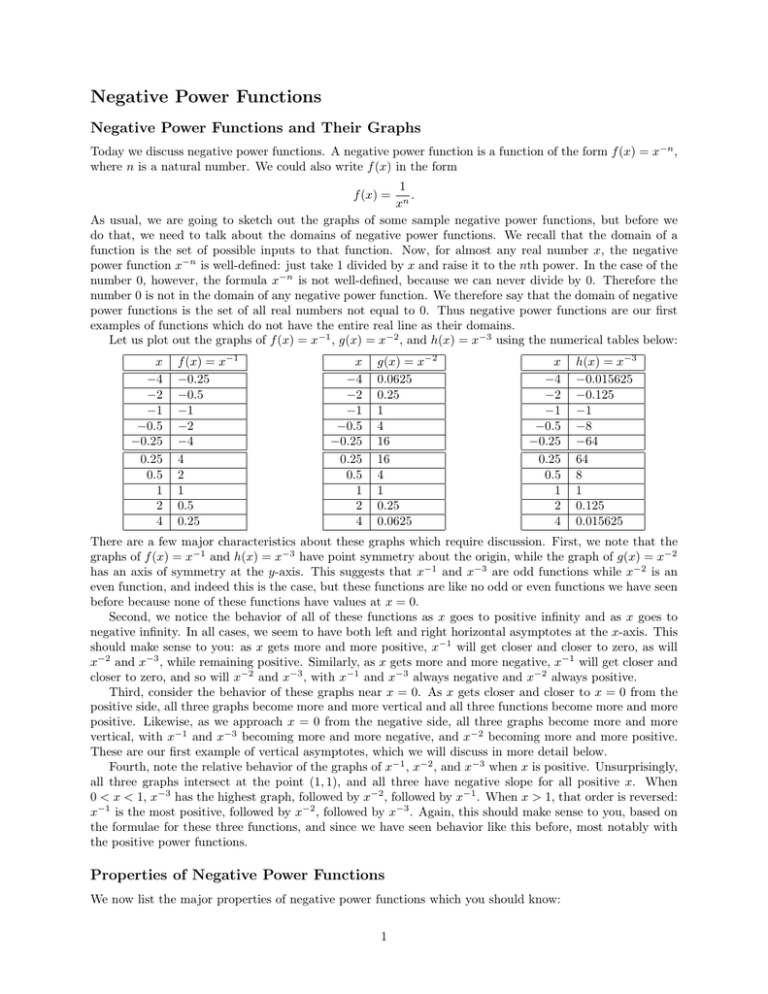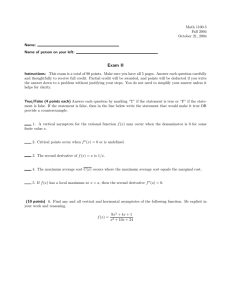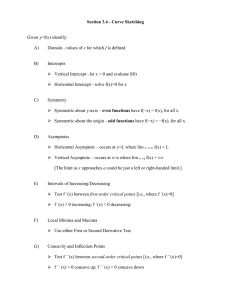Negative Power Functions
advertisement

Negative Power Functions
Negative Power Functions and Their Graphs
Today we discuss negative power functions. A negative power function is a function of the form f (x) = x−n ,
where n is a natural number. We could also write f (x) in the form
1
.
xn
As usual, we are going to sketch out the graphs of some sample negative power functions, but before we
do that, we need to talk about the domains of negative power functions. We recall that the domain of a
function is the set of possible inputs to that function. Now, for almost any real number x, the negative
power function x−n is well-defined: just take 1 divided by x and raise it to the nth power. In the case of the
number 0, however, the formula x−n is not well-defined, because we can never divide by 0. Therefore the
number 0 is not in the domain of any negative power function. We therefore say that the domain of negative
power functions is the set of all real numbers not equal to 0. Thus negative power functions are our first
examples of functions which do not have the entire real line as their domains.
Let us plot out the graphs of f (x) = x−1 , g(x) = x−2 , and h(x) = x−3 using the numerical tables below:
f (x) =
x
−4
−2
−1
−0.5
−0.25
0.25
0.5
1
2
4
f (x) = x−1
−0.25
−0.5
−1
−2
−4
4
2
1
0.5
0.25
x
−4
−2
−1
−0.5
−0.25
0.25
0.5
1
2
4
g(x) = x−2
0.0625
0.25
1
4
16
16
4
1
0.25
0.0625
x
−4
−2
−1
−0.5
−0.25
0.25
0.5
1
2
4
h(x) = x−3
−0.015625
−0.125
−1
−8
−64
64
8
1
0.125
0.015625
There are a few major characteristics about these graphs which require discussion. First, we note that the
graphs of f (x) = x−1 and h(x) = x−3 have point symmetry about the origin, while the graph of g(x) = x−2
has an axis of symmetry at the y-axis. This suggests that x−1 and x−3 are odd functions while x−2 is an
even function, and indeed this is the case, but these functions are like no odd or even functions we have seen
before because none of these functions have values at x = 0.
Second, we notice the behavior of all of these functions as x goes to positive infinity and as x goes to
negative infinity. In all cases, we seem to have both left and right horizontal asymptotes at the x-axis. This
should make sense to you: as x gets more and more positive, x−1 will get closer and closer to zero, as will
x−2 and x−3 , while remaining positive. Similarly, as x gets more and more negative, x−1 will get closer and
closer to zero, and so will x−2 and x−3 , with x−1 and x−3 always negative and x−2 always positive.
Third, consider the behavior of these graphs near x = 0. As x gets closer and closer to x = 0 from the
positive side, all three graphs become more and more vertical and all three functions become more and more
positive. Likewise, as we approach x = 0 from the negative side, all three graphs become more and more
vertical, with x−1 and x−3 becoming more and more negative, and x−2 becoming more and more positive.
These are our first example of vertical asymptotes, which we will discuss in more detail below.
Fourth, note the relative behavior of the graphs of x−1 , x−2 , and x−3 when x is positive. Unsurprisingly,
all three graphs intersect at the point (1, 1), and all three have negative slope for all positive x. When
0 < x < 1, x−3 has the highest graph, followed by x−2 , followed by x−1 . When x > 1, that order is reversed:
x−1 is the most positive, followed by x−2 , followed by x−3 . Again, this should make sense to you, based on
the formulae for these three functions, and since we have seen behavior like this before, most notably with
the positive power functions.
Properties of Negative Power Functions
We now list the major properties of negative power functions which you should know:
1
• Domain: If f (x) = x−n for some natural number n, then the domain of f is the set of all of the real
numbers not equal to 0. We write this in set notation as
Dom(f ) = {x ∈ R : x 6= 0},
where Dom(f ) stands for the domain of f and R is the symbol for the real numbers (this way of writing
R with double lines is used in blackboard writing by mathematicians and is called blackboard bold).
You should read the symbol ∈ as “in” or as “is a member of,” and the colon means “such that.” Thus
the symbols inside the brackets read, “the set of all x in the real numbers such that x is not equal to
0.”
Notice from the graphs of x−1 , x−2 , and x−3 that negative power functions are discontinuous at x = 0:
their graphs have a break in them. Also notice that, because negative power functions are undefined for
x = 0, they do not have derivatives at x = 0 either. So negative power functions are not differentiable
everywhere, although they are differentiable wherever they are defined.
• Evenness and Oddness: As noted above, if f (x) = x−n and n is an even natural number, then f (x)
is an even function, as verified below:
f (−x) = (−x)−n =
1
1
1
=
= n = x−n = f (x).
n
n
n
(−x)
(−1) x
x
Similarly, if g(x) = x−n and n is an odd natural number, then g(x) is an odd function:
1
1
1
=
=
= −(x−n ) = −g(x).
(−x)n
(−1)n xn
−(xn )
g(−x) = (−x)−n =
The one major caveat here is caused by the domains of f and g: since g is not defined at x = 0, we no
longer must conclude that g(x), being an odd function, must have g(0) = 0. The graphs of x−1 and
x−3 show that this is clearly not the case. What is true is that if g is defined for x, it is also defined
for −x, and g(−x) = −g(x). In other words, g is odd where it is defined.
• Horizontal Asymptotes: Again, let f (x) = x−n where n is a natural number. As x gets more and
more negative, f (x) gets closer and closer to 0, and as x gets more and more positive, f (x) also gets
closer and closer to 0. Thus we have both a left horizontal asymptote and a right horizontal asymptote,
which we write, respectively, as
lim x−n = 0
and
x→−∞
lim x−n = 0.
x→∞
• Vertical Asymptotes: Here we have a new behavior. Let f (x) = x−n , where n is an even natural
number. As x gets closer and closer (approaches) to 0 from the positive (right) side, f (x) gets more
and more positive, approaching positive infinity. This is called a right vertical asymptote, and, on a
graph, it is represented by the graph becoming more and more vertical as it approaches some value of
x from the positive side, so that eventually it looks like a vertical line, in this case x = 0. We write
the right vertical asymptote of f (x) using limit notation in the following way:
lim f (x) = lim+ x−n = +∞.
x→0+
x→0
Likewise, f (x) also has what is called left vertical asymptote at x = 0: as x gets approaches 0 from the
negative (left) side, f (x) gets more and more positive, again approaching positive infinity. We write
the left vertical asymptote of f (x) using limit notation in the following way:
lim f (x) = lim− x−n = +∞.
x→0−
x→0
Now let g(x) = x−n where n is an odd natural number. As we observed when we plotted the graphs of
x−1 and x−3 , g(x) also has both a left vertical asymptote and a right vertical asymptote at x = 0. As
x approaches 0 from the right, g(x) becomes more and more positive, approaching positive infinity:
lim g(x) = lim+ x−n = +∞.
x→0+
x→0
2
As x approaches 0 from the right, however, g(x) becomes more and more negative, approaching negative
infinity:
lim g(x) = lim x−n = −∞.
x→0−
x→0−
So, if a function has both a left vertical asymptote and a right vertical asymptote at some value of x,
the two vertical asymptotes do not have to go in the same direction: one can go to positive infinity,
and the other to negative infinity.
In general, we say that a function h(x) has a right vertical asymptote at x = a if as x approaches a
from the positive side, h(x) either gets more and more positive, approaching positive infinity, or h(x)
gets more and more negative, approaching negative infinity:
lim h(x) = +∞
or
x→a+
lim h(x) = −∞.
x→a+
Likewise, we say that h(x) has a left vertical asymptote at x = a if as x approaches a from the negative
side, h(x) either approaches positive infinity or approaches negative infinity:
lim h(x) = +∞
or
x→a−
lim h(x) = −∞.
x→a−
Differentiating Negative Power Functions
The derivatives of negative power functions are, thankfully, easy to remember. Let f (x) = x−n , where n is
a natural number. Then f (x) has a derivative everywhere but at x = 0 (where the function is not defined)
and that derivative is
df
= −nx−n−1 .
dx
Does this rule look familiar? It should, because it is the same rule as we use to differentiate positive power
functions: put the exponent out in front, and drop the exponent by 1. Thus we have a new general rule: let
g(x) = xk , where k is any integer. Then g(x) has a derivative wherever it is defined, and that derivative is
dg
= kxk−1 .
dx
Now that we have this rule, let us apply it. First, we have an easy example: let h(x) = x−17 . Then the
derivative of f (x) is
f 0 (x) = −17x−18 .
Notice that the exponent became −18, not −16. This is a common mistake among students, and you should
be aware of it.
1
Next, let k(x) = x+2
. This function is the composition of two other functions: the inside function is
x + 2, and the outside function is x−1 . If we want to find the derivative of k(x), we need to use the Chain
Rule, and the Chain Rule still applies to functions whose domains are not the entire real line, but only where
the composition k(x) is defined. Where is k(x) defined? Begin with the outside function: x−1 is defined
when x 6= 0. This means that k(x) is not defined when the inside function, x + 2, is equal to 0. The function
x + 2 is equal to 0 precisely at x = −2. Therefore the domain of k is
Dom(k) = {x ∈ R : x 6= −2}.
Now k(x) has a derivative on its domain, and that derivative is given by the Chain Rule:
k 0 (x) = −1(x + 2)−2 · 1 = −
1
.
(x + 2)2
This formula for k 0 (x) is only defined when x 6= −2.
Let us try one last example: let p(x) = (sin(x))−3 . Notice how we wrote the exponent outside of the
cosine function, not on the inside: for negative integers, and in particular for −1, we always write the
exponent on the outside. Now, p(x) is clearly the composition of two functions, the outside function being
3
x−3 and the inside function being sin x. As before, we first need to be aware of the domain of p, because the
domain will restrict down the values of x for which p has a derivative. Just as before, we begin by looking at
the domain of the outside function, x−3 , which is all real numbers not equal to 0. This tells us that p(x) is
not defined when the inside function, sin x, is equal to 0. There are an infinite number of values of x where
sin x is not equal to 0: in particular, sin x = 0 precisely when x = kπ, where k is any integer. So these are
precisely the x values where p(x) is not defined, that is
Dom(p) = {x ∈ R : x 6= kπ, k ∈ Z}.
(The blackboard bold Z is the symbol for the integers. It is Z because the German word for number is
zahlen.) The derivative of p(x) is defined everywhere on its domain, and, by the Chain Rule, it has the
formula
−3 cos x
.
p0 (x) = −3(sin x)−4 · cos x = −3(cos x)(sin x)−4 =
sin4 x
4


